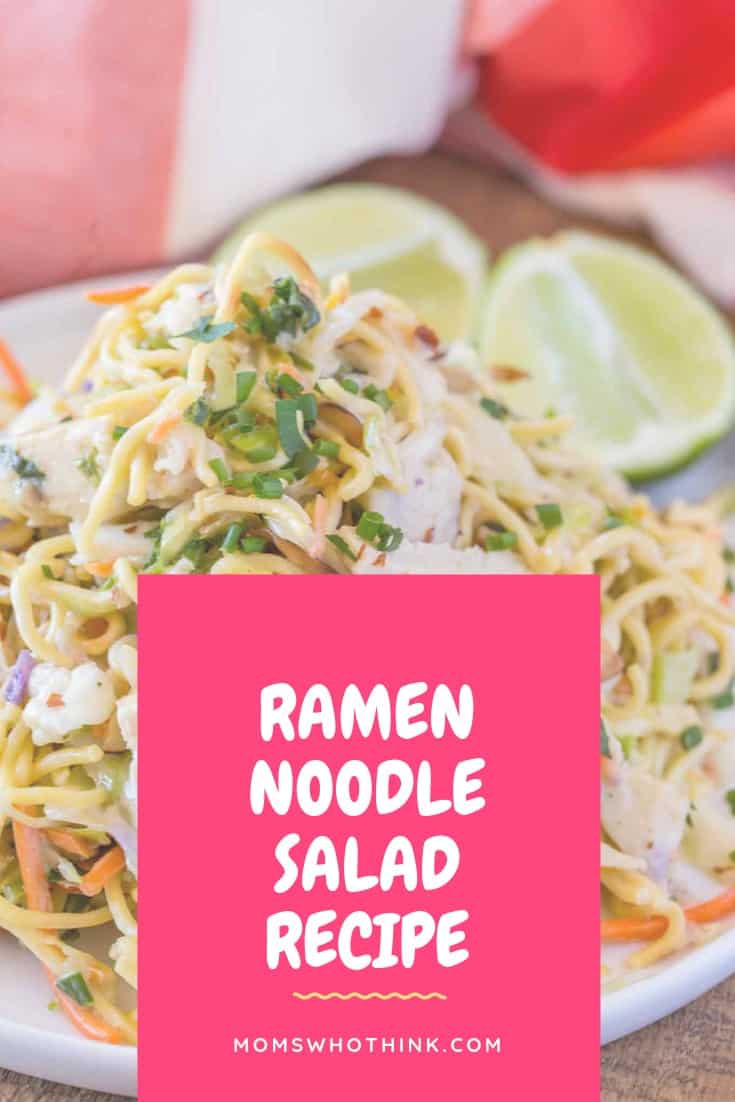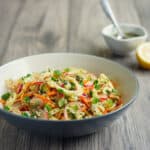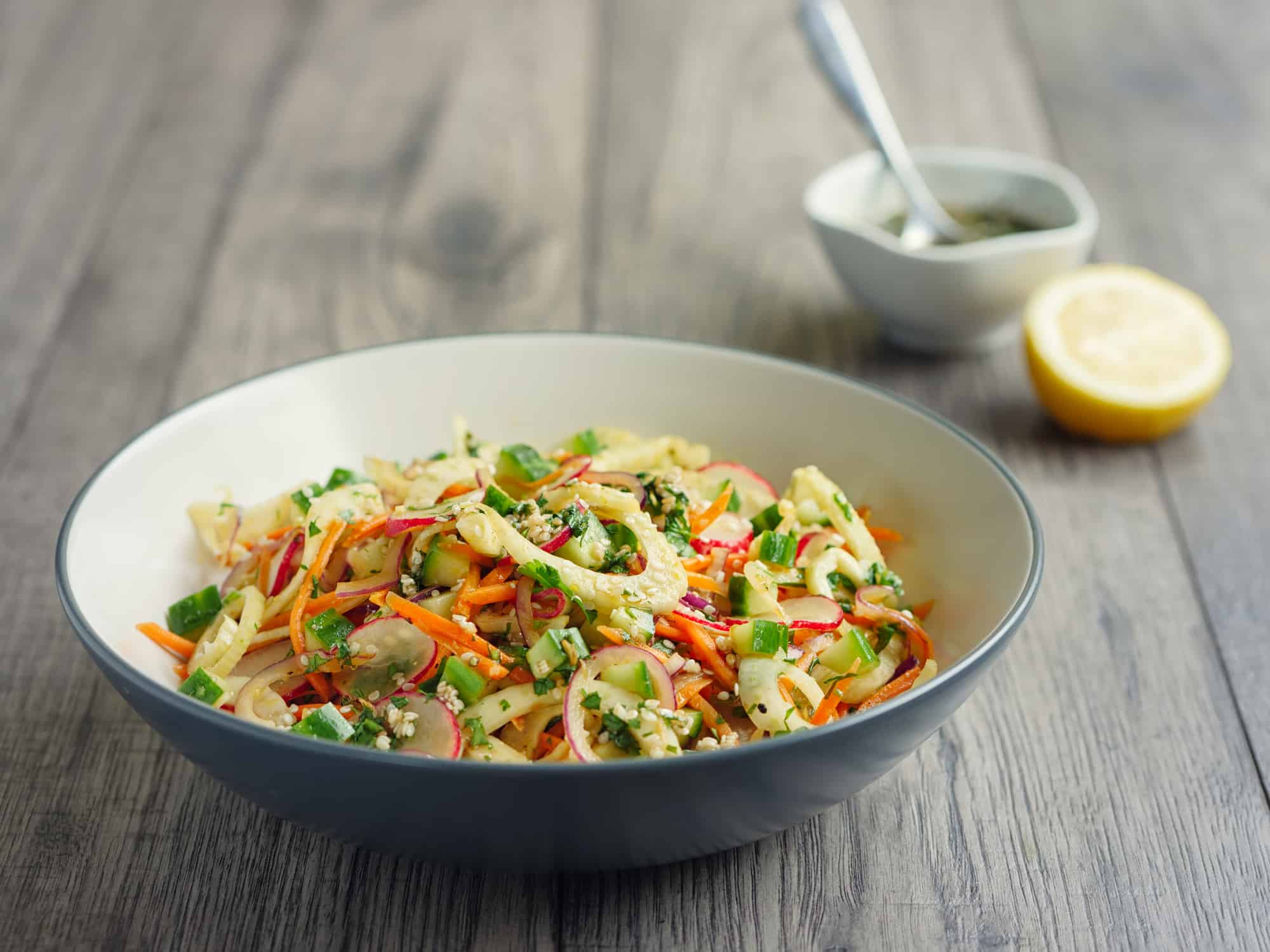Ramen noodles were once known as an inexpensive staple for college students everywhere. But today, these noodles seem to be everywhere, including on the menus of high-end restaurants.
We're getting on board by offering this great Ramen noodle salad recipe. But before finding out about that recipe, let’s find out more about Raman noodles and why they are so popular.
Ramen noodles are wheat-based noodles native to Asia. There is some debate as to whether they were introduced in Japan or China, but it’s likely that they were first seen in China and then skyrocketed in popularity once Japan caught on to the trend.
Early on, the noodles were sold in the street by Chinese workers. Their popularity was said to have soared when Japanese soldiers came back from the war with a new appreciation for Chinese cuisine.
The noodles became even more popular when policemen were shown eating them during a live news broadcast regarding a hostage situation. Ramen finally came to America in the early ’70s branded as Cup o’ Noodles. Later on, Ramen noodles would be found in grocery stores in block form sold in a thin, plastic wrapping.
Many say the noodles gained gourmet status with the opening of New York’s Momofuku Noodle Bar. If the legend is correct, this was the first of many restaurants to serve hand made Ramen noodles in a savory broth.
Ramen Salad
Ramen salad is one way to put a spin on this popular noodle dish. It can be made in a variety of ways, but the recipe often starts by putting fresh vegetables in a bowl. You can use any you’d like, but shredded cabbage, green onions, and carrots are recommended.

Next, you will want to add the dressing. You can make your own dressing or use one that is store-bought. Light balsamic flavor will work perfectly. The noodles are then added. To be clear, these are uncooked to give the salad just the right amount of crunch. The dressing will work to soften them a bit.
Any flavor of Ramen can be added, although chicken is recommended. The seasoning pack should be included as well.
Toss these together in a bowl and refrigerate for eight hours. Then, you will have a dish that can work well as a side or a main course. Ingredients like almonds and snow peas can be added to taste.
Ramen salads are great because they are extremely easy to make. Although Ramen noodles are admittedly not the healthiest food, they give the salad a great crunch and the addition of the veggies ups the health factor by quite a bit.
Ramen Noodle Cole Slaw
If you are thinking of other ways to be adventurous with your Ramen noodles, Ramen coleslaw is another dish you can make.
Ramen coleslaw is quite similar to Ramen salad and uses much of the same ingredients. The main difference is that more cabbage is used. You can also use a store-bought coleslaw mix.
This is a great alternative to traditional coleslaw and it provides a great, tangy taste.
To make Ramen cole slaw, start by mixing green onions, cabbage or coleslaw mix, toasted sesame seeds, toasted slivered almonds, and Ramen noodles. Once again, the Ramen noodles will be raw to provide a great crunch. Packets should be crushed before adding so that noodles get separated.
As with the coleslaw salad, the dressing that is added can be store-bought or you can make it yourself. One recipe for the dressing calls for adding the flavor packets into the mix. Other ingredients include red wine or white vinegar, oil, sugar, salt, and black pepper. Ingredients can be combined with a whisk.
This coleslaw also contains several healthy ingredients, including the vegetables, which are rich in vitamins and minerals. The nuts are full of omega 3’s and healthy fats. It is also a great alternative to traditional coleslaw, which has a high calorie content due to the mayonnaise.
Because this coleslaw is so similar to the Ramen salad, there is no reason why it can’t be served as a main dish. But, because it bears the name coleslaw, most will choose to serve it as a side dish. It will make the perfect complement to your favorite sandwich.
Ramen has gone from a dorm room staple to a gourmet restaurant favorite. What innovative recipes will you be able to create using this inexpensive noodle product?
If you enjoyed this recipe, make sure to check out our Ratatouille Recipe and our Shrimp Salad Recipe.
Print
Ramen Noodle Salad
- Total Time: 25 Minutes
Description
This Oriental Coleslaw with almonds and seeds is loaded with spicy-sweet flavors and ramen for the perfect crunch!
Ingredients
- 1/2 head green cabbage, chopped
- 1/2 carrot, shredded
- 4 green onions, chopped
- 1 package ramen noodles (Oriental flavor)
- 2 tablespoons slivered almonds, sunflower seeds, or sesame seeds
Dressing (whisk or shake together):
- 1/2 cup salad oil
- 3 Tablespoons balsamic vinegar
- 3 Tablespoons sugar
- 1 teaspoon salt
- 1/2 teaspoon pepper
- Flavor packet from ramen noodles
Instructions
- Toast the nuts or seeds in a warm oven for 6-8 minutes, watching carefully to prevent over-toasting. Cool.
- Combine cabbage, carrots and onions.
- Break up noodles and add to vegetables.
- Shortly before serving, add nuts or seeds and the mixed dressing; toss well.
- Prep Time: 15 Minutes
- Cook Time: 10 Minutes
- Category: Salad
- Method: Tossed
- Cuisine: Asian
Ramen Nutritional Info
Many Americans want to know what the nutritional info of their food is. Whether you're on a diet, need to limit your intake of certain nutrients, or are simply looking to be a more informed consumer, we've got all the info you'll need about ramen here.
Ramen does come with a decent amount of thiamin and folate. Folate is especially necessary for pregnant women, since it aids in healthy fetal development. Ramen also contains a small amount of manganese, iron, niacin, and riboflavin.
Unfortunately, ramen has a high amount of sodium. One pack of ramen contains almost all of your daily need for sodium. Consuming too much sodium has been linked to an elevated risk for stomach cancer, heart disease, and stroke. Recent research is mixed on how much sodium intake is healthy, but they all can agree on one thing: moderation is key.
Ramen also contains TBHQ, a preservative. While this preservative is fine in small doses, frequent consumption can lead to health complications. It's important to keep in mind that all of this nutritional info is for instant ramen, not the homemade ramen that you'll find in restaurants. If you make your own ramen, you can use less sodium and avoid TBHQ entirely.
It's safe to eat ramen in moderation. You should, however, avoid eating it frequently. It's tempting to eat it frequently due to its cheap cost and good taste, but for the sake of your health you should try to avoid letting it become a main part of your diet.
If you enjoyed this recipe, feel free to check out our other recipes! We have hundreds of recipes on our site, including many that offer a host of health benefits. Enjoy!

